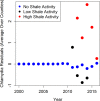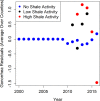Shale gas activity and increased rates of sexually transmitted infections in Ohio, 2000-2016
- PMID: 29570712
- PMCID: PMC5865738
- DOI: 10.1371/journal.pone.0194203
Shale gas activity and increased rates of sexually transmitted infections in Ohio, 2000-2016
Abstract
Background: The growing shale gas ("fracking") industry depends on a mobile workforce, whose influx could have social impacts on host communities. Sexually transmitted infections (STIs) can increase through sexual mixing patterns associated with labor migration. No prior studies have quantified the relationship between shale gas activity and rates of three reportable STIs: chlamydia, gonorrhea, and syphilis.
Methods: We conducted a longitudinal, ecologic study from 2000-2016 in Ohio, situated in a prolific shale gas region in the United States (US). Data on reported cases of chlamydia, gonorrhea, and syphilis by county and year were obtained from the Ohio Department of Health. All 88 counties were classified as none, low, and high shale gas activity in each year, using data from the Ohio Department of Natural Resources. Annual rate ratios (RR) and 95% confidence intervals (95% CIs) were calculated from mixed-effects Poisson regression models evaluating the relationship between shale gas activity and reported annual STI rates while adjusting for secular trends and potential confounders obtained from the US Census.
Results: Compared to counties with no shale gas activity, counties with high activity had 21% (RR = 1.21; 95%CI = 1.08-1.36) increased rates of chlamydia and 19% (RR = 1.27; 95%CI 0.98-1.44) increased rates of gonorrhea, respectively. No association was observed for syphilis.
Conclusion: This first report of a link between shale gas activity and increased rates of both chlamydia and gonorrhea may inform local policies and community health efforts.
Conflict of interest statement
Figures







Similar articles
-
A Multiregion Analysis of Shale Drilling Activity and Rates of Sexually Transmitted Infections in the United States.Sex Transm Dis. 2020 Apr;47(4):254-260. doi: 10.1097/OLQ.0000000000001127. Sex Transm Dis. 2020. PMID: 32168285 Free PMC article.
-
Fracking and public health: Evidence from gonorrhea incidence in the Marcellus Shale region.J Public Health Policy. 2017 Nov;38(4):464-481. doi: 10.1057/s41271-017-0089-5. J Public Health Policy. 2017. PMID: 28827566
-
Fracking and risky behaviors: Evidence from Pennsylvania.Econ Hum Biol. 2018 Sep;31:69-82. doi: 10.1016/j.ehb.2018.08.001. Epub 2018 Aug 10. Econ Hum Biol. 2018. PMID: 30170297
-
Rapid diagnostic methods in sexually transmitted infections.Infect Dis Clin North Am. 2008 Dec;22(4):601-617. doi: 10.1016/j.idc.2008.05.010. Infect Dis Clin North Am. 2008. PMID: 18954754 Review.
-
Epidemiology of sexually transmitted diseases. What does it tell us?Sex Transm Dis. 1994 Mar-Apr;21(2 Suppl):S81-3. Sex Transm Dis. 1994. PMID: 8042124 Review.
Cited by
-
Petro-riskscapes and environmental distress in West Texas: Community perceptions of environmental degradation, threats, and loss.Energy Res Soc Sci. 2020 Dec;70:101798. doi: 10.1016/j.erss.2020.101798. Epub 2020 Oct 8. Energy Res Soc Sci. 2020. PMID: 33072520 Free PMC article.
-
Hygroscopic effect of high clay-content shale under temperature and humidity conditions and its impact on mechanical properties.PLoS One. 2025 Mar 7;20(3):e0319672. doi: 10.1371/journal.pone.0319672. eCollection 2025. PLoS One. 2025. PMID: 40053538 Free PMC article.
-
Assessing Exposure to Unconventional Oil and Gas Development: Strengths, Challenges, and Implications for Epidemiologic Research.Curr Environ Health Rep. 2022 Sep;9(3):436-450. doi: 10.1007/s40572-022-00358-4. Epub 2022 May 6. Curr Environ Health Rep. 2022. PMID: 35522388 Free PMC article. Review.
-
A Multiregion Analysis of Shale Drilling Activity and Rates of Sexually Transmitted Infections in the United States.Sex Transm Dis. 2020 Apr;47(4):254-260. doi: 10.1097/OLQ.0000000000001127. Sex Transm Dis. 2020. PMID: 32168285 Free PMC article.
-
Eviction From Renter-occupied Households and Rates of Sexually Transmitted Infections: A County-level Ecological Analysis.Sex Transm Dis. 2019 Jan;46(1):63-68. doi: 10.1097/OLQ.0000000000000904. Sex Transm Dis. 2019. PMID: 30148755 Free PMC article.
References
-
- Ohio Department of Natural Resources. Shale Development and Activity 2017. Available from: http://oilandgas.ohiodnr.gov/shale.
-
- Howarth RW, Santoro R, Ingraffea A. Methane and the greenhouse-gas footprint of natural gas from shale formations. Climatic Change. 2011;106(4):679 10.1007/s10584-011-0061-5 - DOI
Publication types
MeSH terms
Grants and funding
LinkOut - more resources
Full Text Sources
Other Literature Sources

